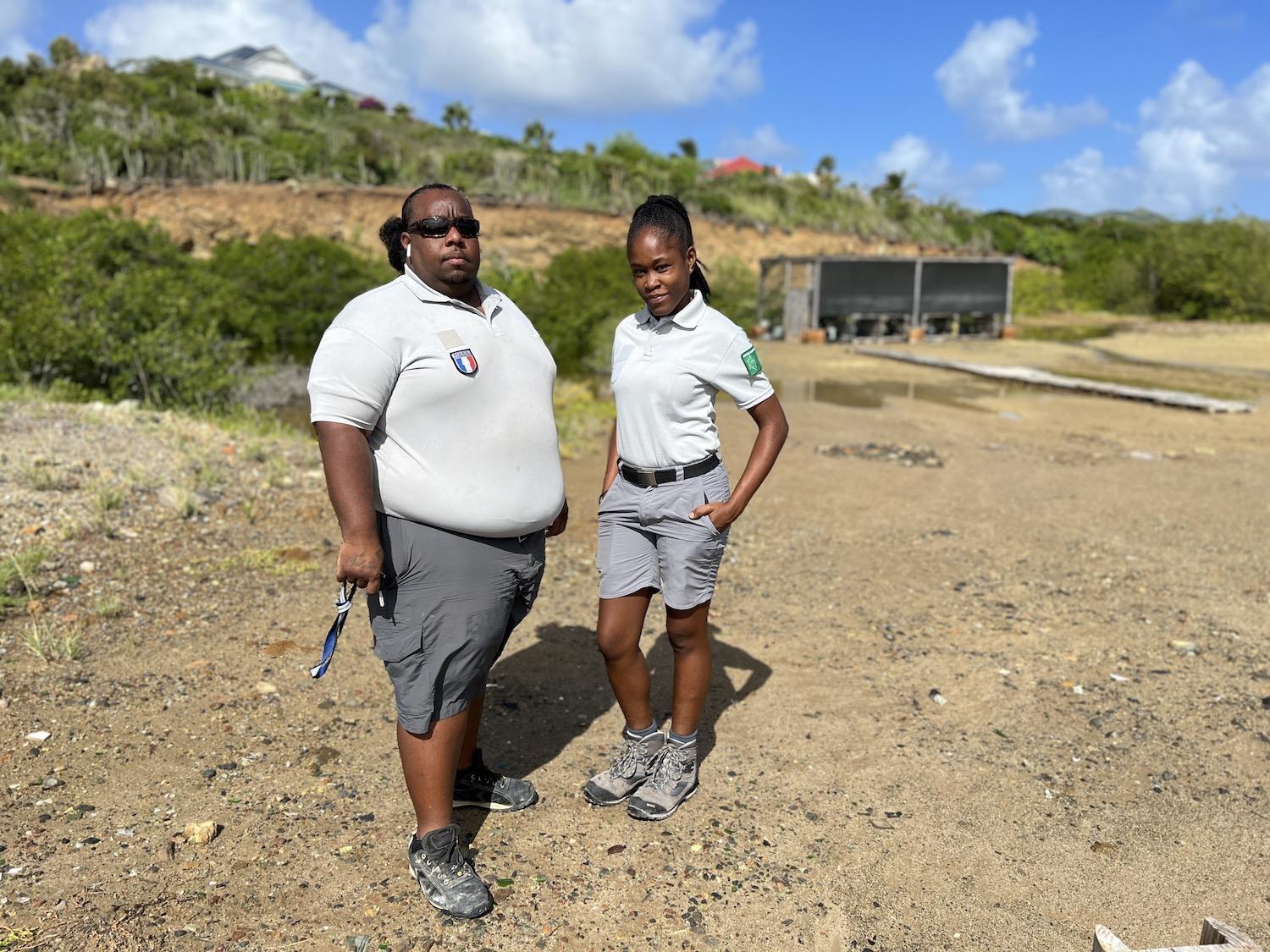
Chris Joé and Ashley Daniel, environmental police officers with the St. Martin Nature Reserve, stand in front of their mangrove nursery on the French side of the Caribbean Island/Jennifer Bain
On Patrol At The St. Martin Nature Reserve
By Jennifer Bain
Peeking through the viewing slots on the wooden observation platform at Étang de la Baie Lucas, we don’t need binoculars to see an embarrassment of wildlife. Large iguanas are nestled in the mangroves, including one bright green female and two males that have turned reddish-orange to display dominance and attract mates. There’s a Brown Pelican on the rocks. In the water, a Snowy Egret looks for food near a Great Egret and Spotted Sandpiper as four White-Cheeked Pintail ducks putter merrily about.
Not a bad haul for just a few minutes at this tiny pond on the French side of the Caribbean island of St. Martin (the other side, Sint Maarten, is Dutch and home to the famous airport where planes fly low over Maho Beach to land).
“The birds don’t see you when you come here, so you get a chance to observe them,” says Ashley Daniel, an environmental police officer and avid birder with the Réserve Naturelle Saint-Martin.
I’m spending the morning with Daniel, and her colleague Chris Joé, as they patrol the coastal land that they are sworn to protect. The seas are unfortunately too rough to hop in their 29-foot boat and patrol the more extensive marine area.
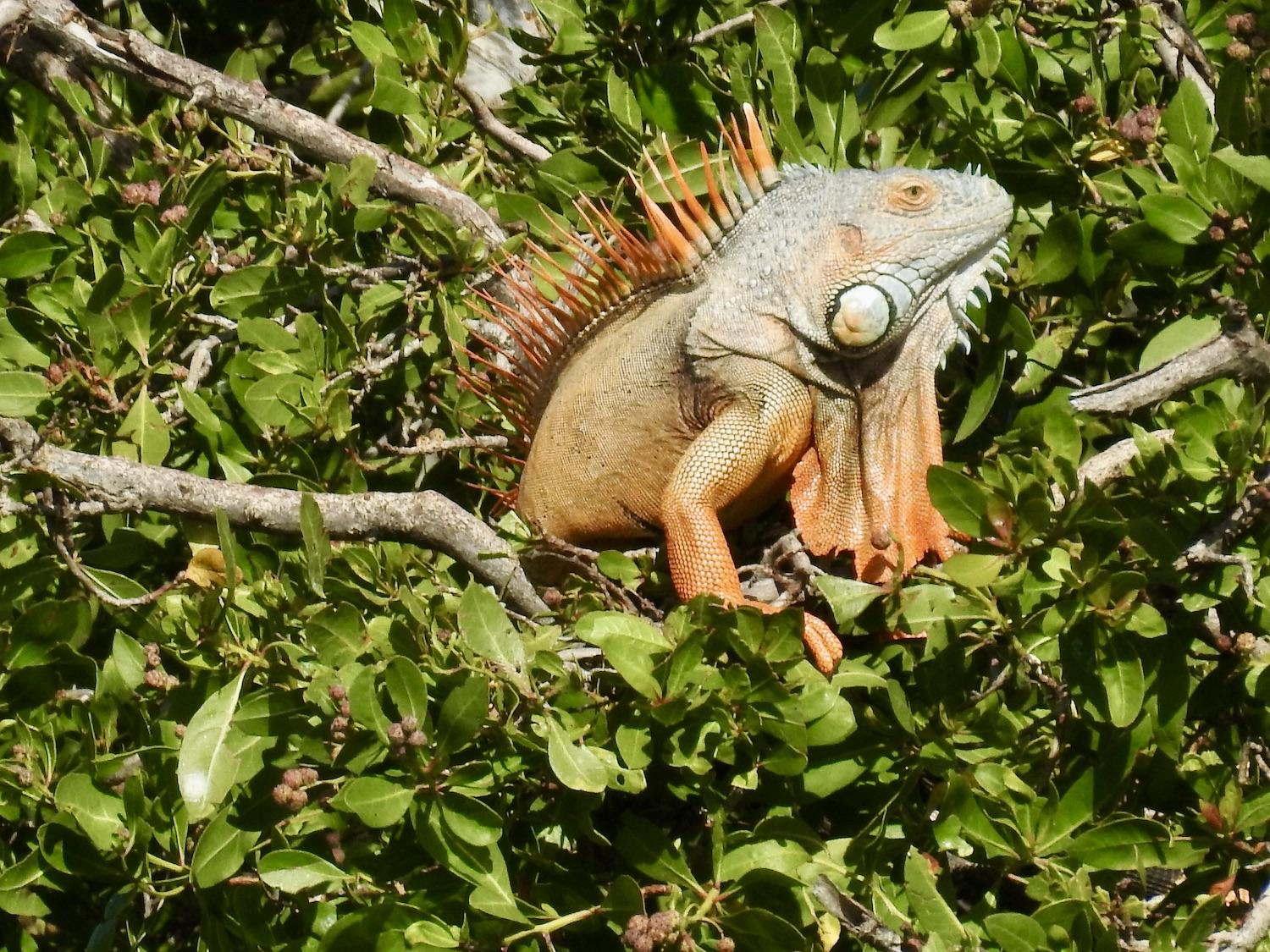
Tourists love the Green Iguanas of St. Martin, especially when the males turn orange. But they're also a much-loathed invasive species/Jennifer Bain
Étang de la Baie Lucas is part of a network of ponds protected by the Conservatoire du Littoral (another government organization) and the St. Martin Nature Reserve. This fragile wetland is one of the island’s remaining mangrove stands and the pond — while small — is a refuge for numerous birds. Since the island is also on a migratory flyway for birds that breed in North America and then winter in the Caribbean and Latin America, it attracts more than 90 species. (The iguanas, it should be stressed, may excite a casual observer but are a destructive invasive species.)
“The ponds of St. Martin create a corridor of wetland habitat between land and sea. Bird colonies move from pond to pond, depending on water levels, available food and other factors,” interpretive signage explains. “Be patient, be discreet and good luck.”
What do people see when they look at seemingly simple ponds like this? This one is along a high-traffic road on the eastern edge of St. Martin, between the seaside communities of Oyster Pond and Orient Bay. Most people drive right by. It may seem like a small thing, but I always spend a moment reading interpretive signs for a deeper, richer experience.
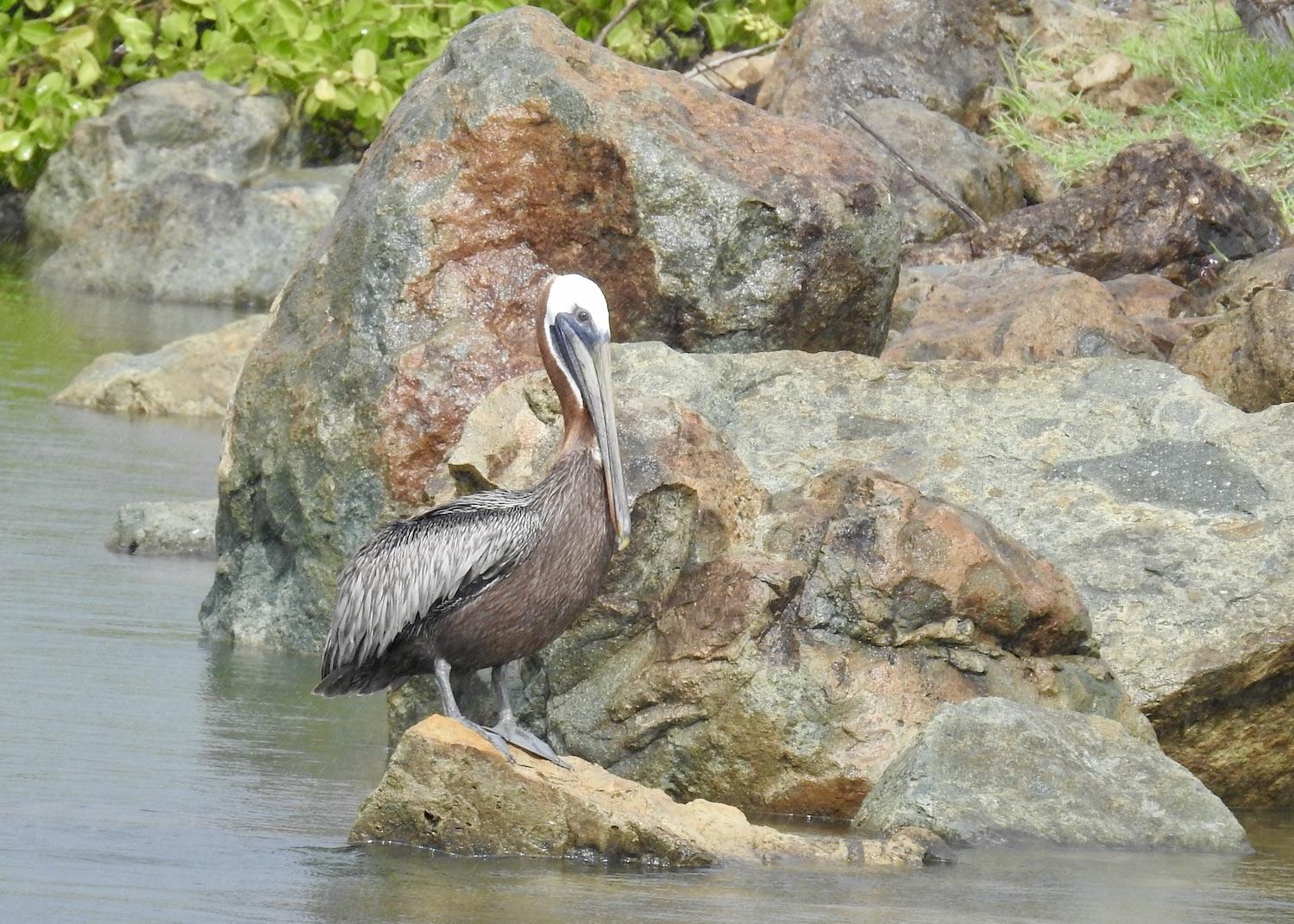
A Brown Pelican stands on the rocky shore of Étang de la Baie Lucas/Jennifer Bain
The signs posted here on the observation platform reveal that this pond was formed 10,000 years ago when a sand bar separated the pond from the nearby sea. The pond is fed by an intermittent freshwater stream and brackish water seeping through the sandbar from the sea. It’s enclosed by plutonic (quartz diorite) and volcanic (andesite) rock, and the boulders at the water's edge were created by erosion.
I don’t know much about the mangroves at the water’s edge, but read how they’re intertwined with a fringe of drought-tolerant species. On the other side of the pond, mangroves reportedly lead to dry scrubland, grasslands and dry coastal forest full of Frangipani and Jamaican Caper trees. The fact that the pond’s watershed is still undeveloped makes the setting of this unassuming wetland “quite remarkable,” signs say, and I have to agree, even as I learn how it struggled after 2017’s Hurricane Irma and how water from a sewage treatment plant is released into it.
Created in 1998, the nature reserve manages and preserves 7,500 acres and seven miles of coastline, and draws 400,000 visitors a year. Five main ecosystems include the coral reef, mangroves, phanerogam seagrass beds, ponds and coastal forest. The biggest protected area is the marine reserve found on the plateau between the islands of Anguilla, St. Martin and St. Barts. The terrestrial section includes rocky coastline, cliffs, beaches and mangroves. The wetlands around the fish pond and the salt flats of Orient Bay are also protected. So are small islands on the east coast (Pinel, Petite Clef, Green Cay and Tintamarre), the islands of Coconut Grove, and the popular diving spot Creole Rock.
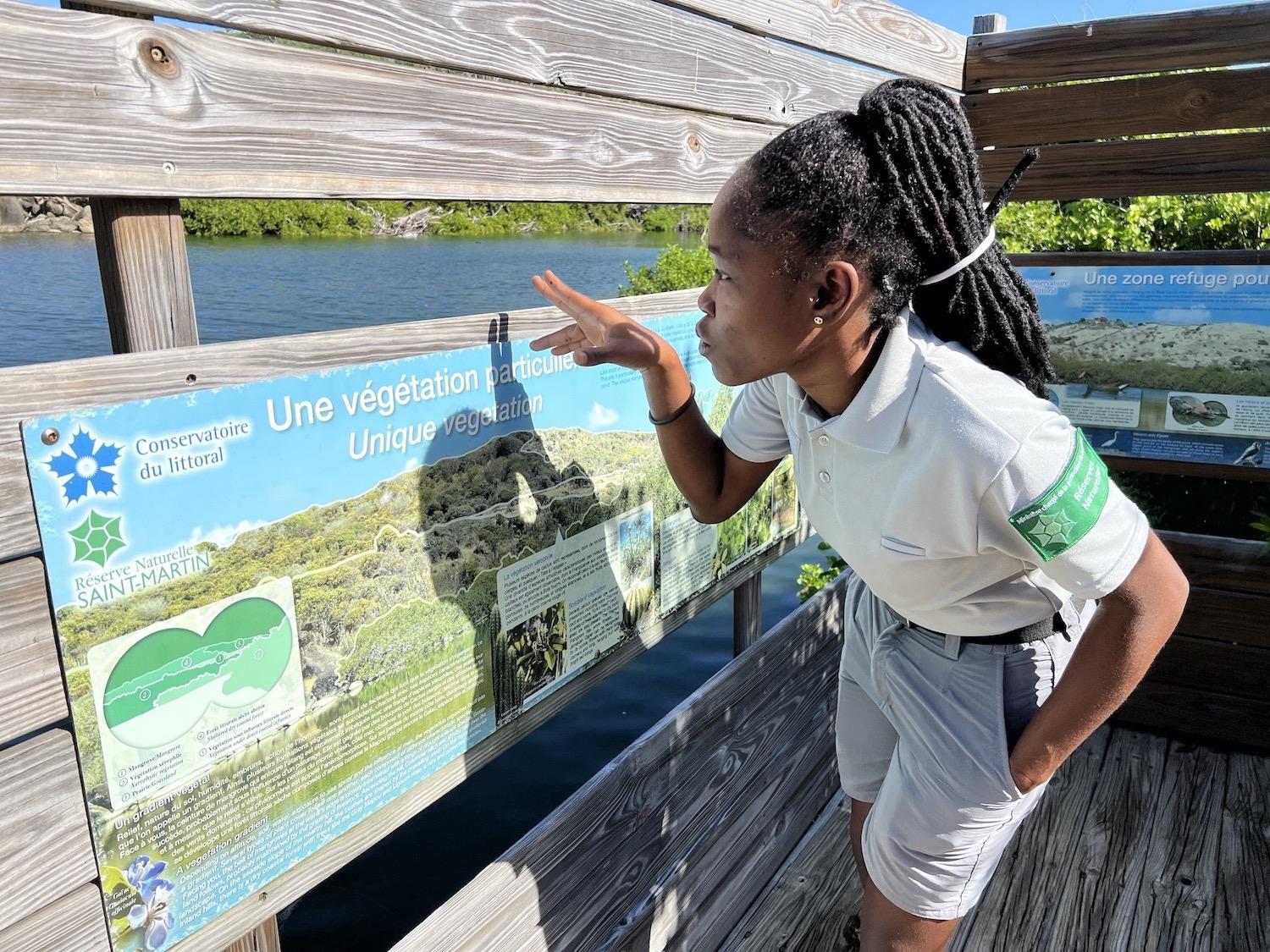
St. Martin Nature Reserve's Ashley Daniel birdwatches at Étang de la Baie Lucas/Jennifer Bain
The reserve has a small team spread over police, education, scientific and life (biodiversity) departments. Joé and Daniel are tasked with ensuring people follow the rules, and they can make seizures and issue warnings and fines. They mainly watch to see if people are fishing (personally or commercially), camping or doing motorized watersports (like jet-skiing and kitesurfing) in restricted zones, or anchoring and causing harm instead of using designated moorings that protect coral reefs. The reserve collects an activity fee from each person that passes through with registered tourism businesses.
After our brief birding moment, we drive by a wooden whale-watching observatory and two much larger salt ponds called Étang du Poissons and Saline d’Orient. We spot a man fishing and, after a spirited debate, he is let off with just a warning. “The problem is that people have lost their jobs and homes, and so you can’t really prosecute everyone for catching a fish,” says Joé. “But a guy with a boat, we will stop.”
The next stop is Le Galion Beach facing Baie de l’Embouchure. Locals love the shallow, calm water, but we're here because it faces the Saline d’Orient where salt was produced from the 1840s to the 1950s. It was picked from boats, spread on shore to dry and then measured, bagged and sold.
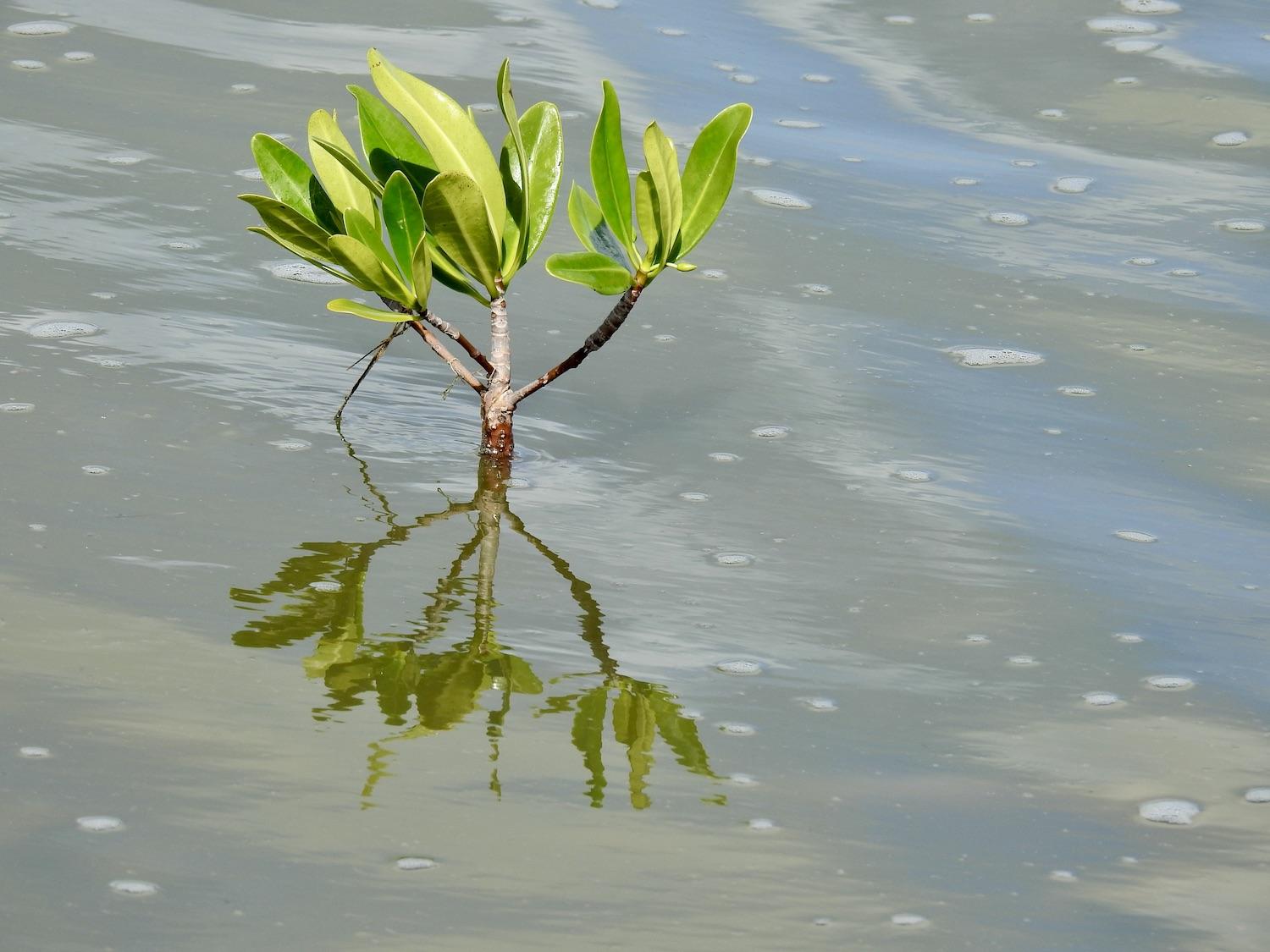
A young red mangrove planted by tourists on an eco tour at Saline d'Orient/Jennifer Bain
Salt ponds act as imporant nurseries and protective barriers. Daniel shows me seeds from four types of mangrove — red, black, white and grey — and two tiny red mangrove “trees” poking out of the water near shore that were planted by cruise ship tourists.
To learn more about that project, we head to the reserve's current pride and joy — a mangrove nursery. Housed in an unassuming structure, between the beach and tourist-packed Orient Bay, the nursery was created after Hurricane Irma caused widespread destruction here in 2017. Mangroves are salt-tolerant small shrubs or trees that grow in coastal saline or brackish water. They're a complex ecosystem that provide breeding/spawning grounds, play a crucial role in groundwater purification, and act as a natural barrier against severe weather.
This nursery also factors into nature training the reserve did with a company called Seagrape Tours. Now when some cruise ships dock on the island, eco-minded guests can opt to spend time with Seagrape, learn about mangrove restoration efforts, plant mangrove seedlings in or near the salt pond, and sometimes even meet with Joé and Daniel.
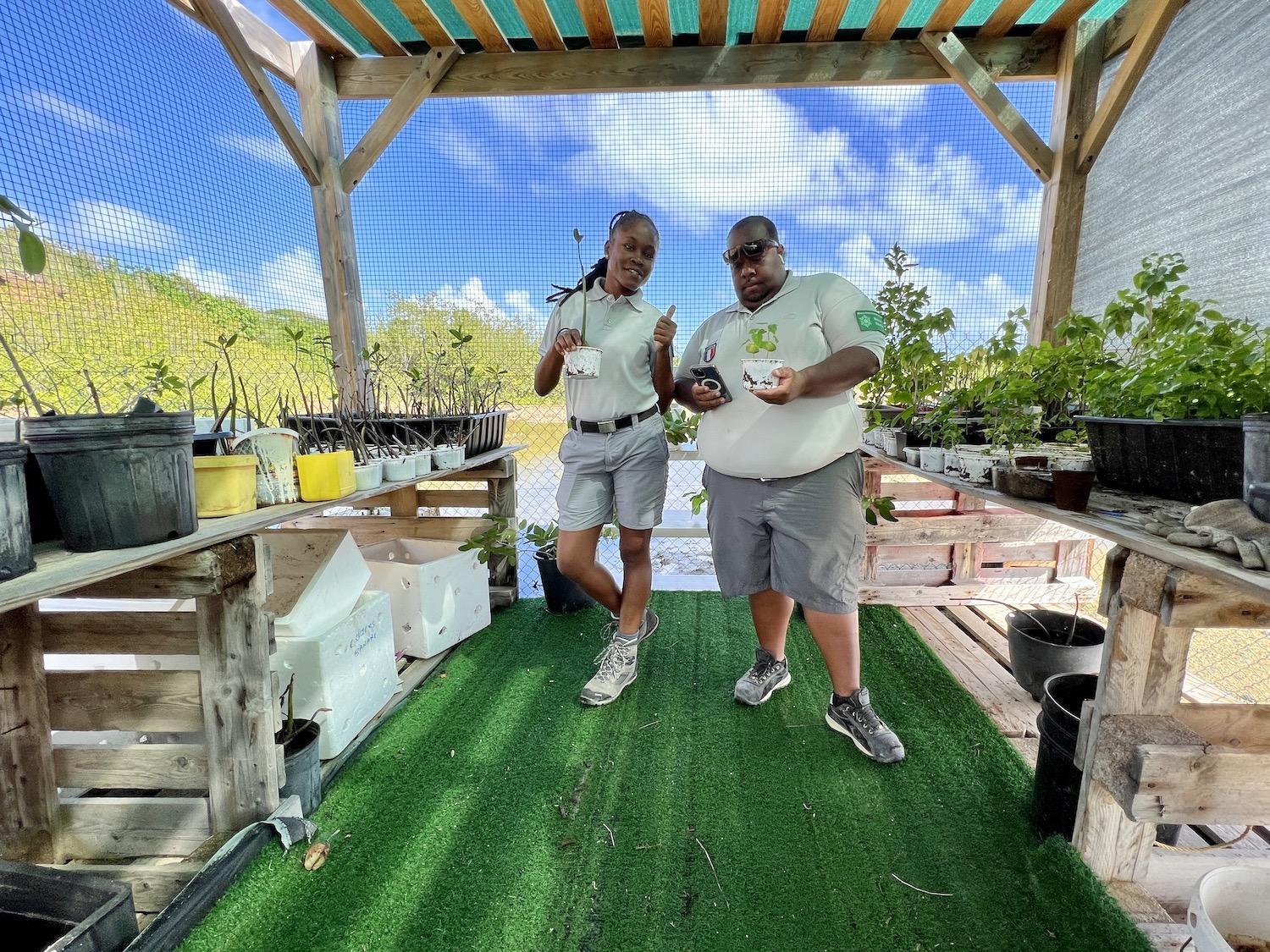
Ashley Daniel and Chris Joé show off the St. Martin Nature Reserve's mangrove nursery/Jennifer Bain
“They’ve been doing that for a few months — we’re waiting for the season to pick up,” says Daniel. “But the feedback we’ve heard is that everyone has been quite happy and satisfied with the experience.”
Two interesting things to note about the plant-filled nursery. Extra screens are in place to keep the hungry iguanas out, and the wooden nooks are popular with Jack Spaniard wasps.
The Common or Green Iguana, I learn, was introduced here in the 1990s and the non-native species always outcompetes and interbreeds with the Lesser Antillean Iguana until it overwhelms it. The critically endangered Lesser Antillean Iguana hasn’t been seen on St. Martin for years.
Jack Spaniards build nests out of paper in dry spaces and sting to defend their nests. The wasps disappeared for about a year after Hurricane Irma destroyed their nests, the flowers they rely on for pollen, the plants they eat and the caterpillars they feed to their young. By early 2019, they were common again. “Although this wasp has a painful sting, it’s an important part of nature on the island,” says Amuseum Naturalis.
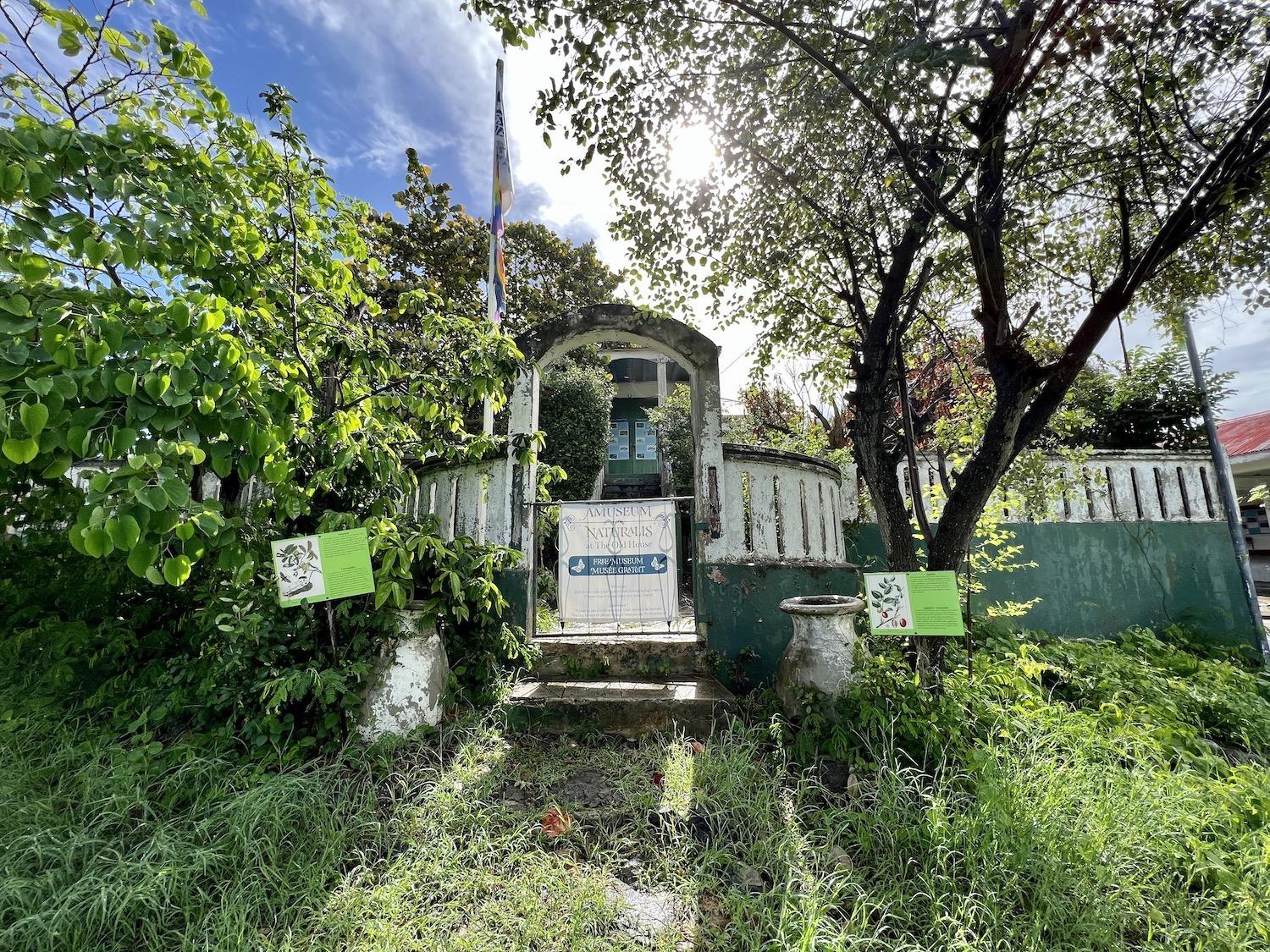
Don't miss Amuseum Naturalis on St. Martin. It's a free and self-guided way to learn about the island's nature and heritage/Jennifer Bain
Amuseum Naturalis is a free, self-guided, outdoor museum located in the historic Old House in the Quartier d’Orléans. Co-founded by Mark Yokoyama and run by the volunteer non-profit association Les Fruits de Mer, it showcases the island's nature and heritage with winding paths, gardens and detailed interpretive signs.
It’s here that I see pretty yellow Bananaquits (Sugar Birds), and where I learn that St. Martin’s stone walls were often built by slaves from stones taken when the land was cleared for farming. The stones are stacked without mortar and are a natural habitat for plants, mosses, ferns, vines, lichens and cacti. “They are made of natural stone and have many places where animals can hide or lay their eggs,” the museum points out. “The walls provide shade during the day and the stones retain the warmth of the sun at night.”
My patrol with the environmental police wraps up with a drive to a seemingly quiet seaside stretch called Grand Cayes, which is unfortunately right beside a busy garbage dump. There is talk of moving the road to the dump back from the ocean, but negotiations are apparently ongoing for the private land.
The beach is lined with reddish brown piles of sargassum seaweed. Most seaweeds are attached to something like rocks or corals, but a couple of kinds of sargassum seaweed are free-floating. Small balls filled with air help this seaweed float. Currents usually keep the sargassum in the middle of the ocean in the Sargasso Sea, but foul-smelling sargassum blooms have been sporadically clogging Caribbean coastlines in recent years.
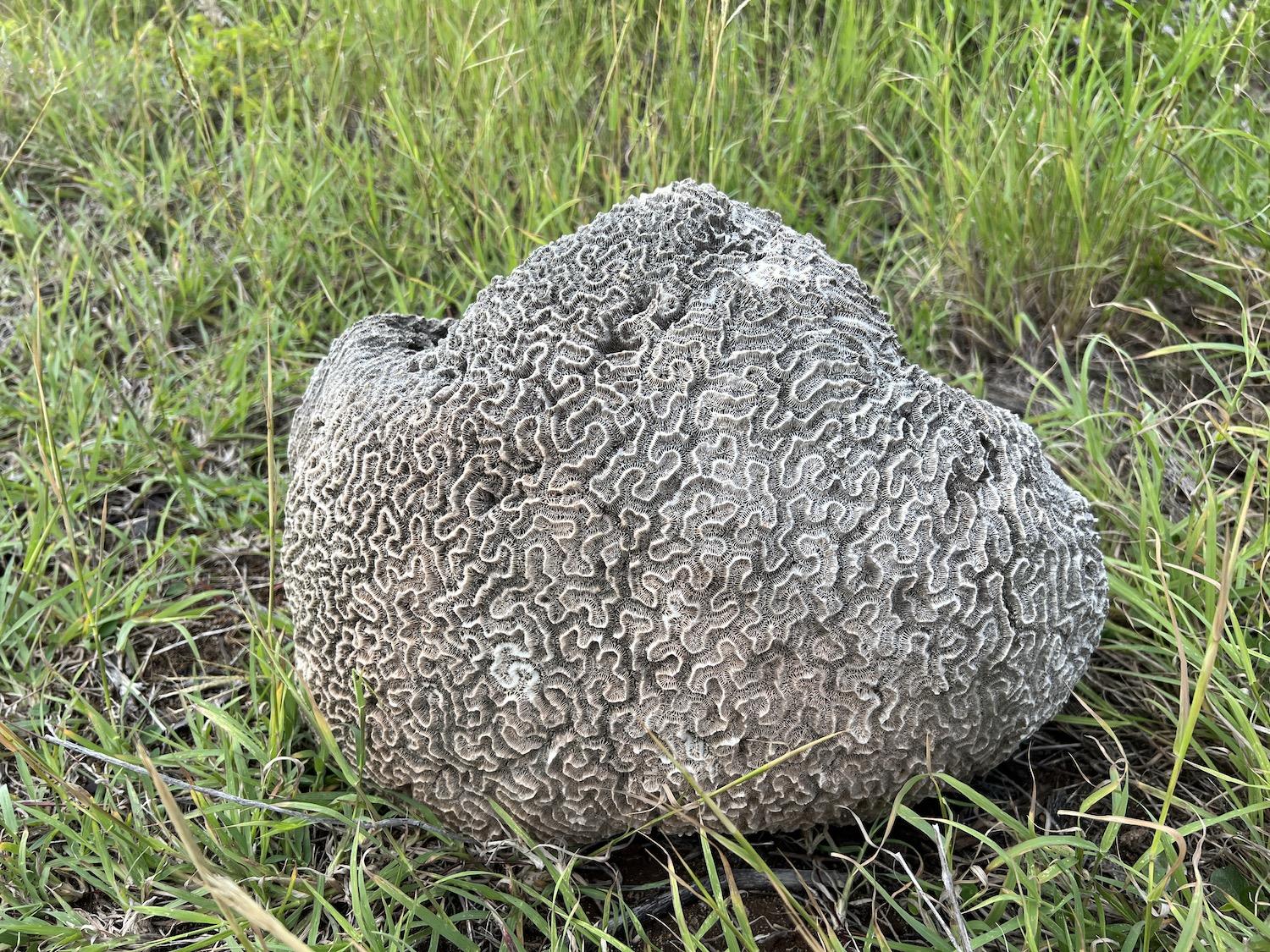
A large piece of what appears to be brain coral is shown on the beach at Pinel Island/Jennifer Bain
It’s here at Grand Cayes that I study one of the newer interpretive signs and learn that on St. Martin’s protected sites, you are not allowed to:
• Catch fish and other marine species (with spearguns, fishing lines, nets, cast nets and keepnets) — but traditional fishing might be authorized.
• Collect and destroy animals (especially corals) or plants, collect sand, collect dead or live animals (including shellfish, Queen conch, crustaceans, sea urchins and spiny lobster).
• Deposit any waste (including dirt, stones and rubbish).
• Do any industrial or commercial activity (including research, mining and sand extraction).
• Do towed or motorized watersports (like jet ski, waterski and wakeboard).
• Anchor in seagrass beds or coral reefs.
It's late November and I read that between March and October, female leatherhead, hawksbill and green turtles nest on these beaches, laying and incubating eggs. Green and hawksbill turtles can be seen year-round near shore on seagrass beds and coral reefs.
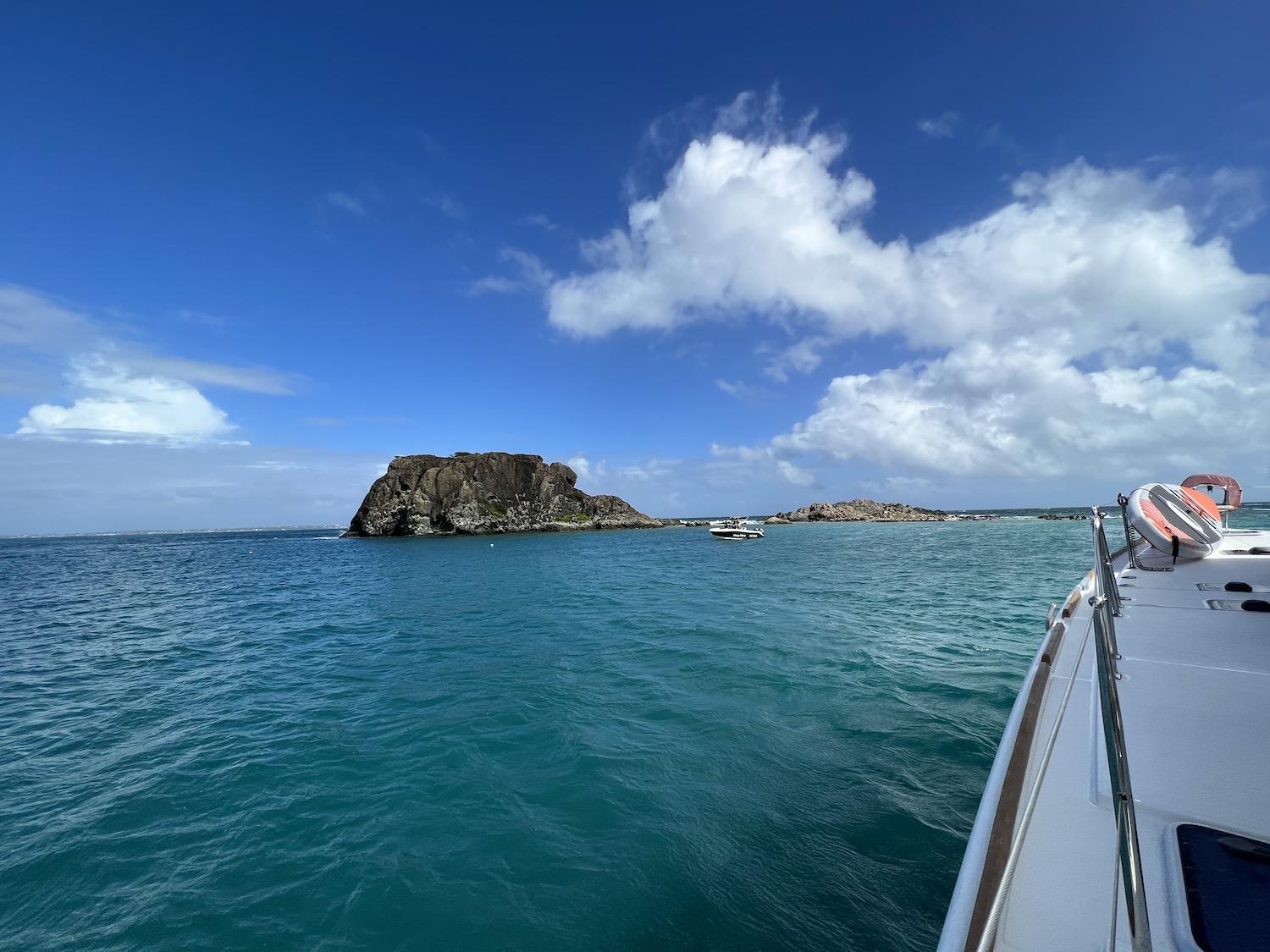
The sea is rough when I sail by Creole Rock with Pyratz Gourmet Sailing. It's popular with divers but protected by the St. Martin Nature Reserve/Jennifer Bain
Two days later, on a private, full-day charter with Pyratz Gourmet Sailing, I do spot several large turtles in the ocean, but don’t get close enough to identify them. Brown Boobies — a "dashing seabird" that All About Birds says is known for swift aerial manoeuvers and deft dives — swoop around the catamaran and we pass by Creole Rock, the diving spot that is also a protected seabird nesting site.
But for the second time during my week on St. Martin, my plans are dashed by wind and so we don’t get to sail to Tintamarre (Flat Island). The protected and uninhabited island is popular with daytrippers seeking sea turtles, dolphins, corals and sea urchins, and has an off-limit area where people once flocked for mud baths. Tintamarre boasts the ruins of an eccentric St. Martin man (“King” Diederik Christian van Romondt) who built an estate around 1904 and hired people to harvest sea island cotton, raise cattle and sheep, and produce butter and cheese. There are also traces of an ill-fated local airstrip.
On another day, I do make it, however to Pinel Island. Like Tinatmarre, it’s protected by the nature reserve. Unlike Tintamarre, it’s close to shore, reachable by a 10-minute ferry ride that operates all day long, and home to two beachfront restaurants.
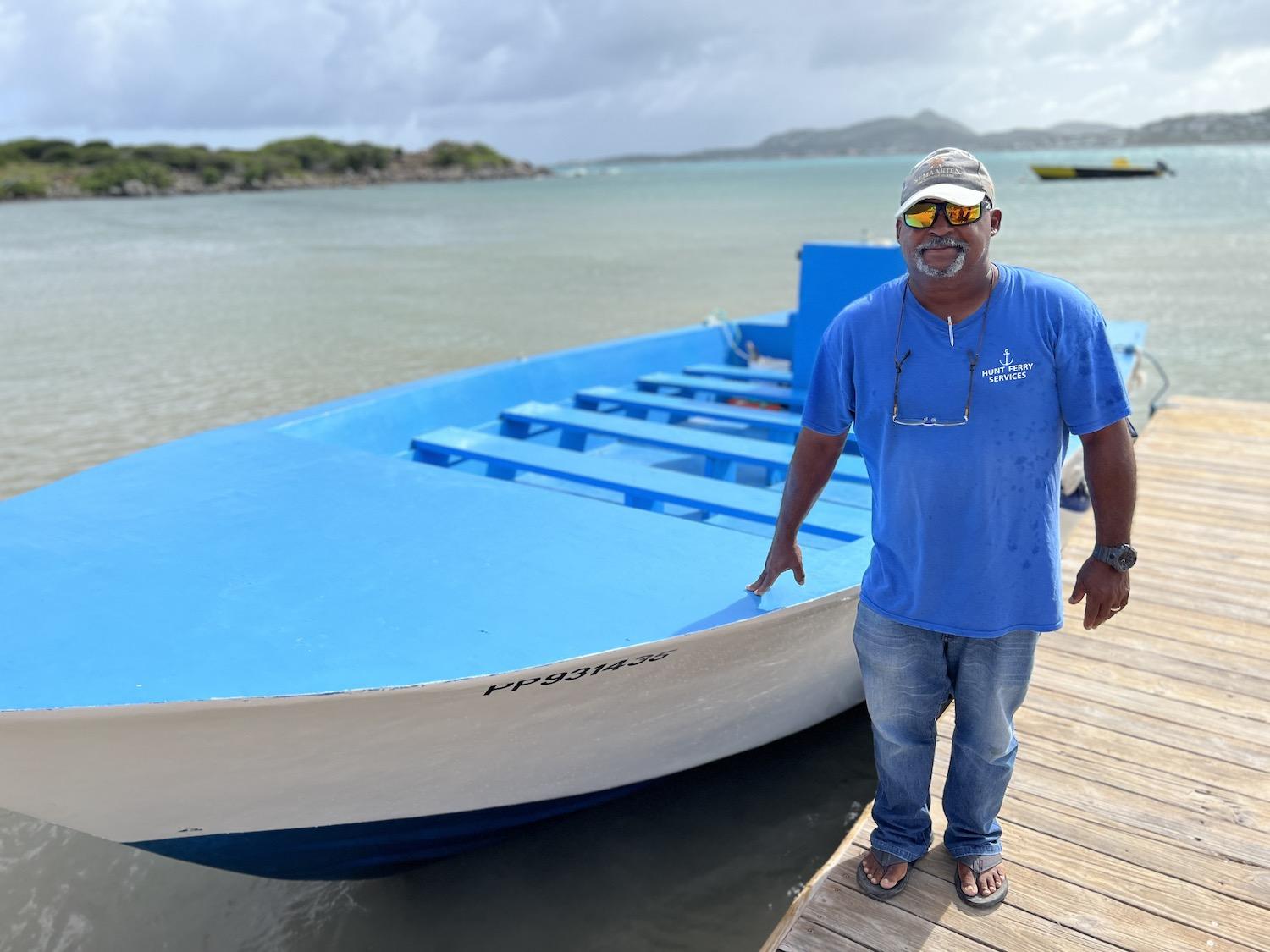
Mike Hunt is one of the captains who ferries people over to Pinel Island, a protected part of St. Martin/Jennifer Bain
“There’s nothing dangerous — just enjoy yourselves,” promises jovial shuttle boat captain Mike Hunt as our group disembarks on Pinel and another group prepares to board to return to St. Martin.
Passing by three interpretive signs obscured by foliage and trying to stay ahead of a storm, I take a quick hike across Pinel and marvel at all the land crabs along the trail, the sargassum-lined beaches, what I think is brain coral washed up on the beach, and two Red-Footed Tortoises.
Most visitors don't pay attention to public toilets, but I’m impressed by the SunwindD Eco2 system that works without water and apparently doesn’t contaminate the ocean. It uses a natural biological process to transform waste into a kind of dehydrated and odorless compost.
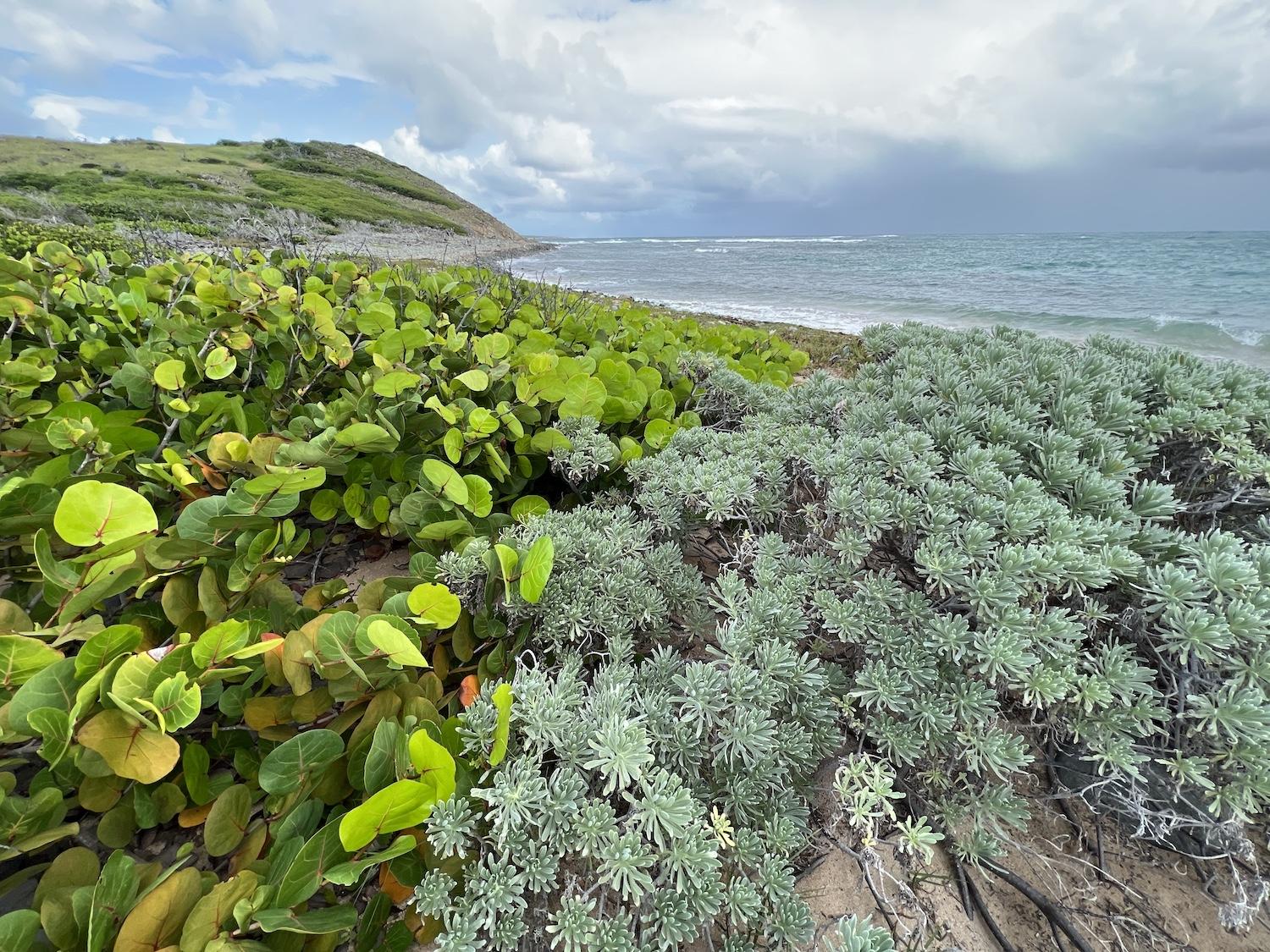
Who needs sandy beaches when you can admire seagrapes and other foliage along the shore of Pinel Island/Jennifer Bain
I’m actually here in the Caribbean for the Festival de la Gastronomie Saint-Martin, and spend most of my week eating dishes wrapped around this year’s star ingredient — plantain (a tropical starchy fruit related to the banana that needs to be cooked). But since I’m not one to relax on a beach or do watersports, I offset the eating with outdoor explorations. That makes me what Daniel calls “a nature-motivated tourist” — the kind she and Joé hope St. Martin sees more of.
For a final outing, I connect with Seagrape Tours, asking that we spend all our time on the French side of the island and as much time as possible in areas under the nature reserve's care. Named for the flowering plant Coccoloba uvifera that abounds here, Seagrape advocates for sustainable tourism and offers private eco, cultural, architectural, art and food tours by van.
The company hopes to boost awareness about conservation.
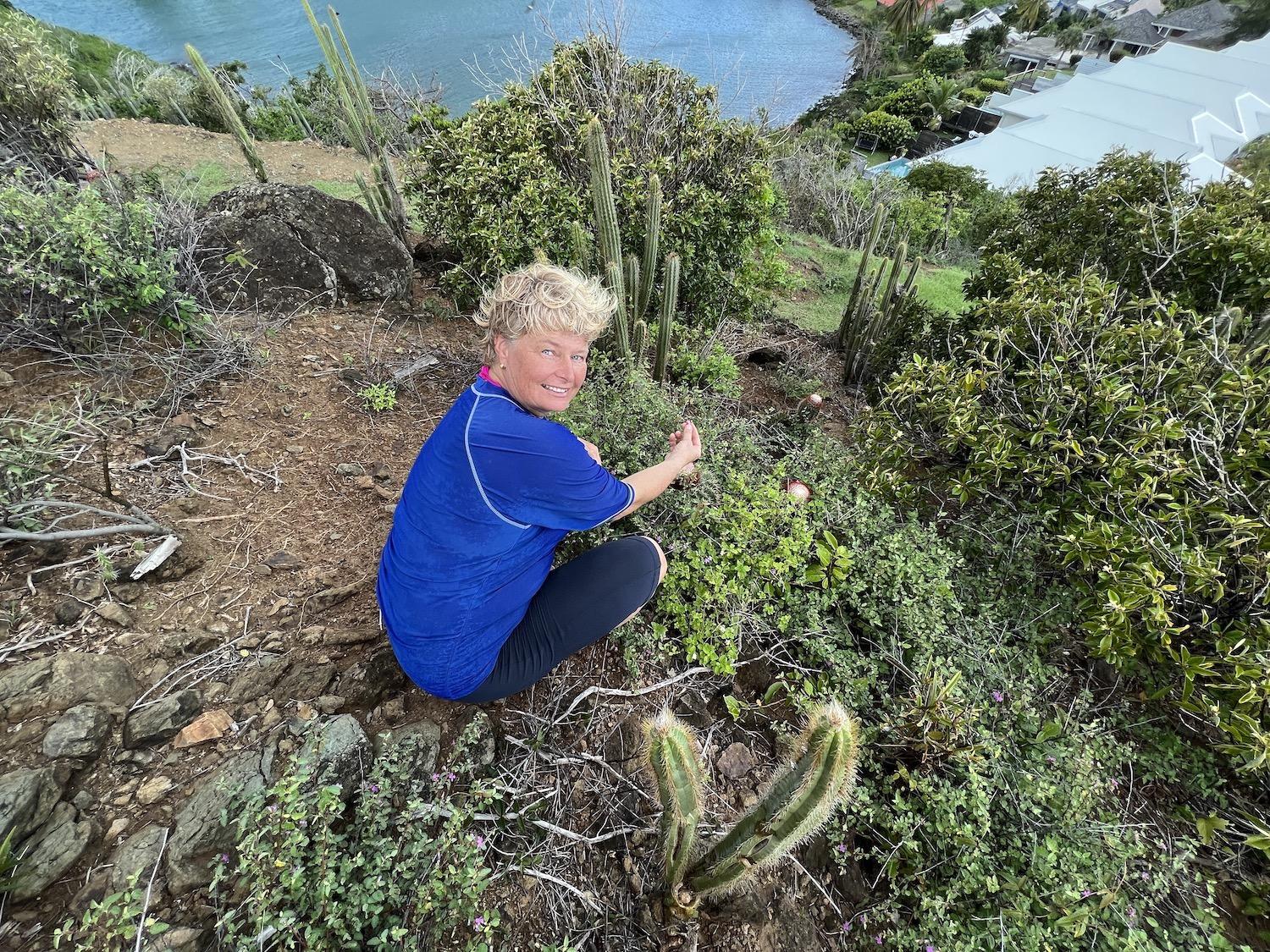
Rikke Bachmann Speetjens, a guide with Seagrape Tours, shows off the biodiversity of Babit Point/Jennifer Bain
Rikke Bachmann Speetjens — who is originally from Denmark and has a biology background but married a man from St. Martin — takes us to a variety of places on a rainy day, including the Amuseum Naturalis, Étang de la Baie Lucas where I later spot all those birds and iguanas with the environmental police, and Pic Paradis, the highest point on the island and the place where I catch a glimpse of two invasive Vervet Monkeys.
But the place that stands out is Babit Point, with its cacti-lined seaside cliffs and wandering donkeys. This magical spot with a desert vibe used to be managed by the nature reserve, but it currently in the hands of the Conservatoire du Littoral, another nature-minded government body charged finding and buying land that should be protected.
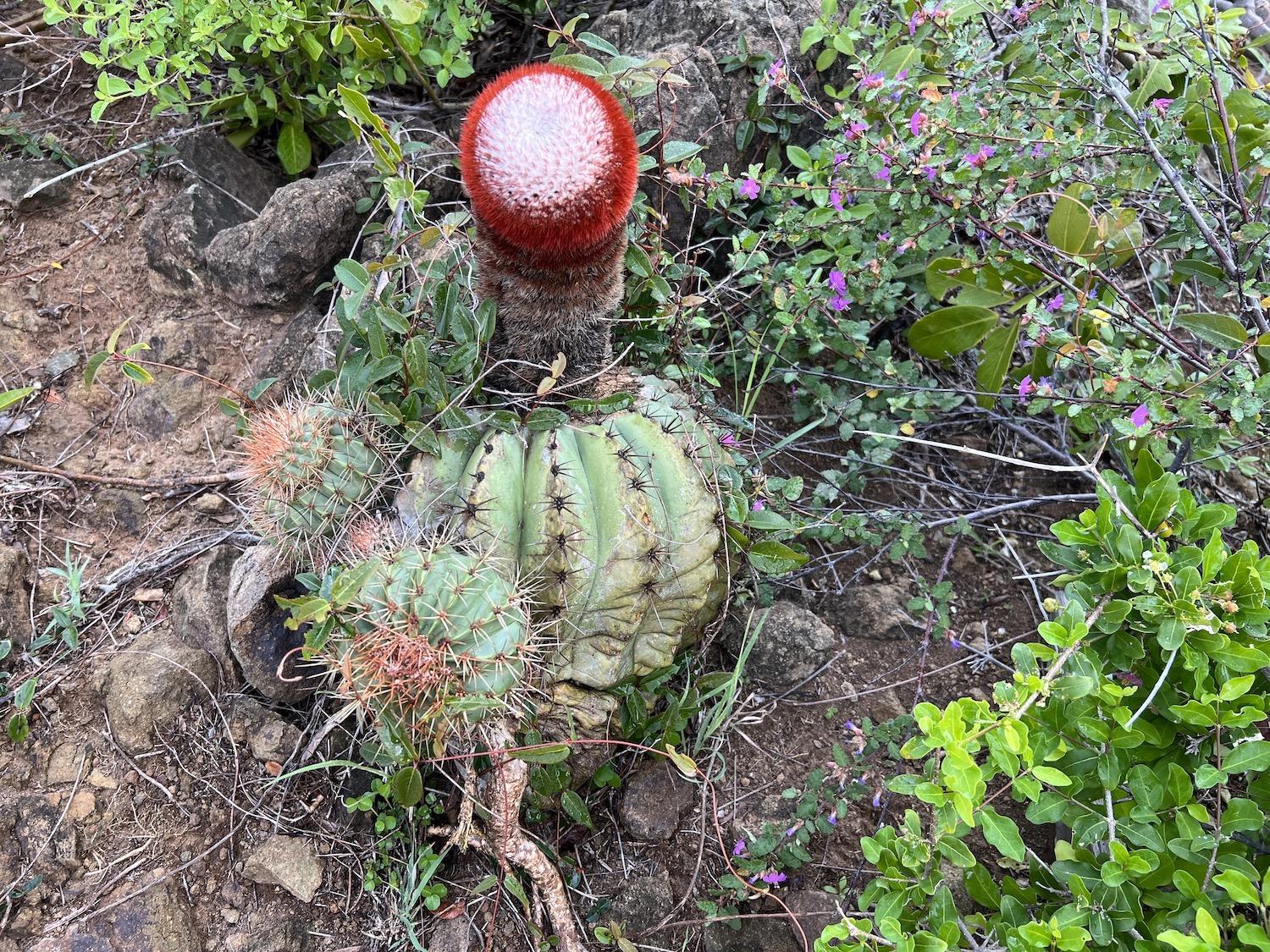
A Turk's Cap Cactus at Babit Point on St. Martin/Jennifer Bain
Babit Point, a rocky point at the extreme southeast part of French St. Martin, is known for its botanical importance. It's one of the last undeveloped spaces around Oyster Pond, which is filled with luxury homes. “If we don’t promote nature,” Speetjens warns, “it will only be so much time before tourists will choose different destinations."
I ogle Turk’s Cap Cactus, a delightfully odd round cactus topped with a fuzzy red knob. There are so many small white butterflies in the air that I can understand why locals have nicknamed them “snowflakes.” I try (and fail) to capture a photo of those fast-moving yellow Bananaquits as they dart about in a feeding frenzy.
LIke the Bananaquits, I love all the fabulous food I get to eat on St. Martin (hello Sandy's Creole Cuisine in Marigot), but I'm even more grateful to feast on nature in between meals.

 Support Essential Coverage of Essential Places
Support Essential Coverage of Essential Places